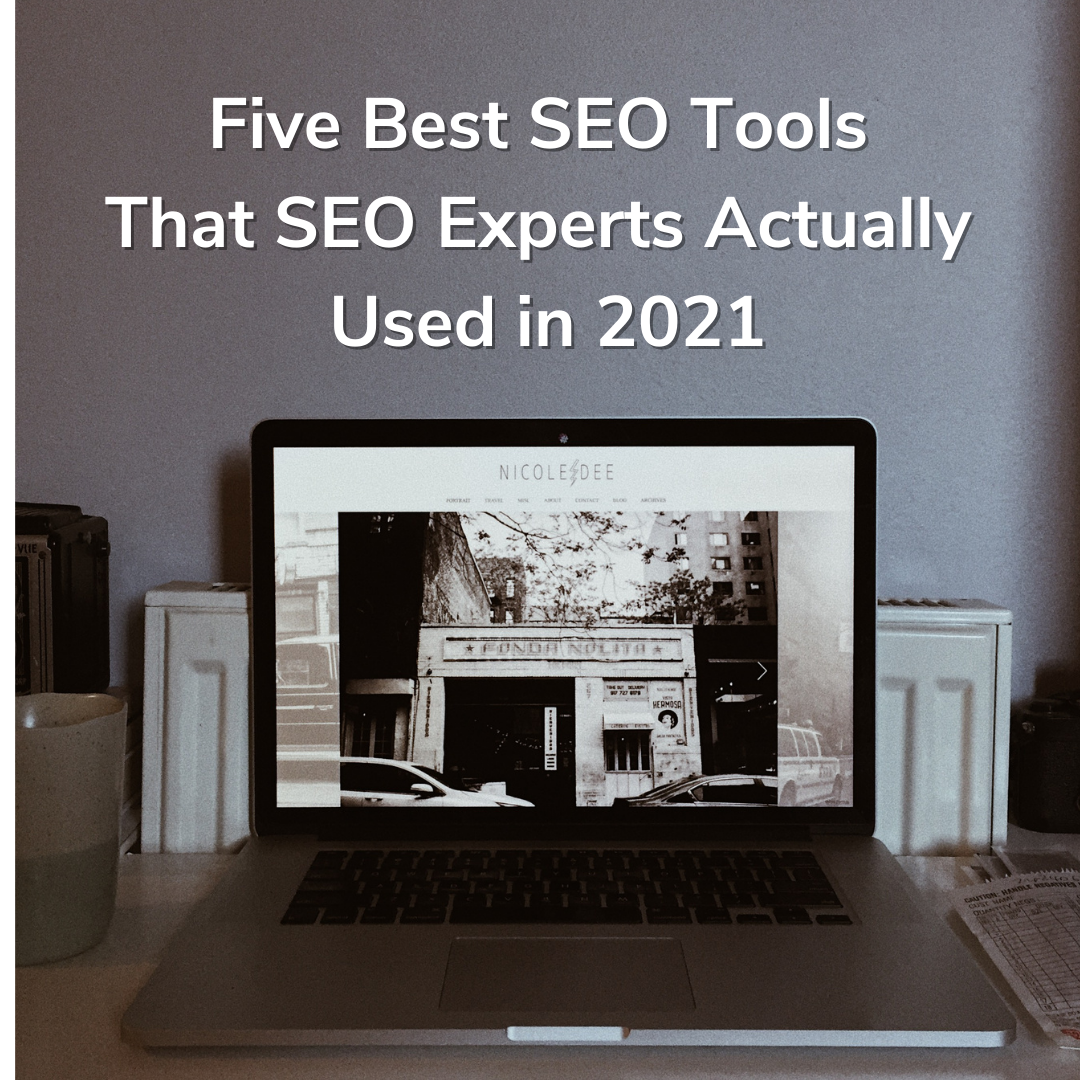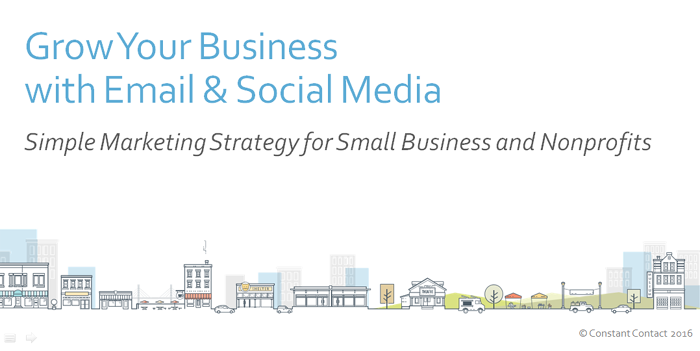
Simple Marketing Strategy for Small Business and Nonprofits
Here’s what we’re going to talk about today:
- –We’ll discuss small business marketing in today’s changing world, and why it’s to your advantage.
- –We will go over some simple steps for creating your own marketing goals.
- –I will show you different tools that really help drive action for you in your messages, and how to choose the right place to promote your message.
- –We’ll talk about the important of measuring your goals in order to make future marketing decisions.
- –And then we will touch on how you can get started, no matter where you’re starting from.
Let’s start with small business marketing in today’s world. It might seem like there’s a lot to keep up with and you only have so many resources to get you there. We’re here to tell you, you do have something no one else can offer.
So, as I said before, marketing has changed with the growth of technology.
Some of the change is obvious, but I want to talk briefly about one of the subtle changes that affects you and your ability to grow your business using all of the new online tools: it’s a basic shift in the way you may find and keep customers with today’s business climate.
Look at this model:
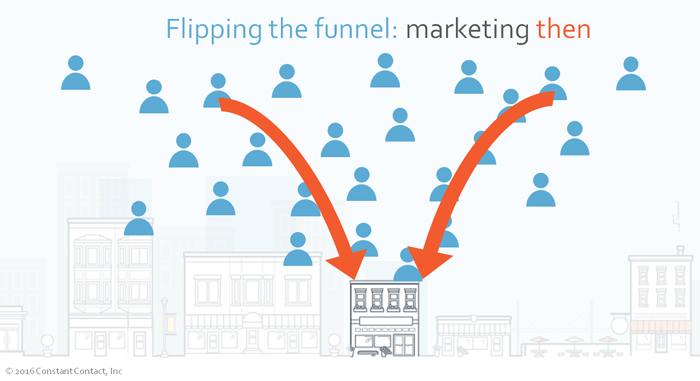
It’s a typical sales funnel, using traditional marketing methods, things like print ads, radio, television, direct mail. This model is all about your reach – reaching out to FIND new customers. it’s bigger at the top, which is where you spend a lot your time, your money and your energy in this model.
And…it makes sense. You reach out to as many people as you can, convert a certain percentage into paying customers and keep even fewer of those people – mainly because so much of your time, money and energy went into the reach at the beginning.
It’s a standard, sales, numbers game and it makes sense. We are all familiar with this model – the problem with this traditional funnel is that it’s expensive – those ads cost a lot of money and it’s hard for a small company or organization to compete in this landscape.
Digital marketing tools have completely flipped the funnel:

When you begin to use new marketing tools, like email marketing, Facebook, linked in, twitter, events, surveys, etc… you reach to people you already know.
This new marketing funnel is about reaching out to people that already know you, and letting THEM spread the word to potential new customers… you reach out, on a regular basis, with information and offers that are relevant to your contacts and it turns out that if you do it right, you will actually begin to convert more people than you are reaching out to, because of your audience’s desire and ability to share your message.
Through this new funnel, you grow your base, your business through repeat business and referrals – at the end of this marketing day, turns out you keep a lot more of your existing customers so you don’t need as many strangers, and it costs less and takes less time and energy.
The flip in the marketing funnel is actually phenomenal news for you as a small business or non-profit and that’s because you have an advantage over “big business” in this new era of marketing, specific to your use of email and social media marketing.
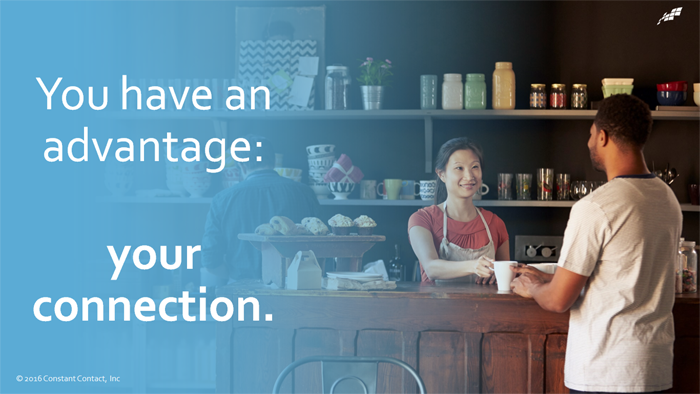
You have an advantage because you can be the face of the company, the person people associate with that business or organization. You can be your authentic self. Big brands cannot do that. Today we’re going to talk about some of the ways you can leverage this advantage.
In this new marketing world, you’ll spend less time finding new customers and more time engaging your existing happy customers. Email and social media have leveled the playing field for smaller organizations like yours and mine to compete with the big boys.
This social visibility allows your customers or members to spread the word about your business. You’ll be able to engage your current customers and even reach new ones.
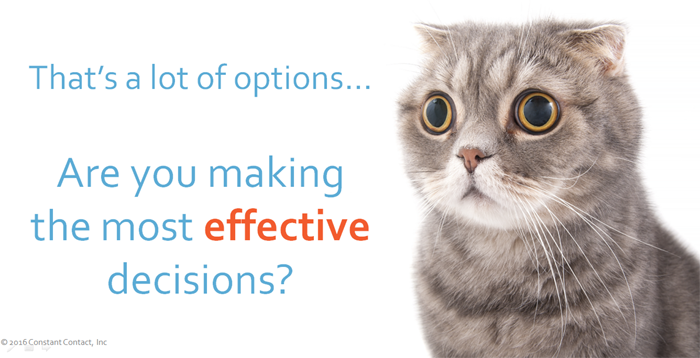
With all these ways to communicate, and not enough time, how do you decide where to spend your time? It’s time to ask yourself: are you really spending your marketing budget in the best way possible?
This is not an uncommon challenge for small businesses. You have tons of platforms that you’re being told you need to manage all at once. And sometimes, that pressure is actually to your disadvantage
So how do you really decide what platform to leverage first? What do you think is the #1 app on smart phones?
The answer is EMAIL. More than 53% of emails are opened on a mobile device. Email is one of the top ways for you to be seen by your customers.Source: (Litmus, January 2015) https://litmus.com/blog/53-of-emails-opened-on-mobile-outlook-opens-decrease-33
Email is hard to beat for real marketing value. It still has the highest delivery and response.

In fact, the Direct Marketing Association reports that email remains unbeaten, with return on investment still at almost $41 per dollar spent. Email really is the best way to reach your clients, or customers which is going to allow you to manage your relationship with them in a huge way.[Source: https://blogs.constantcontact.com/email-marketing-roi/]
But what about social media?
In today’s world, we tell everyone about everything through social media channels, even strangers.
46% of shoppers rely on social media when making a purchase. What’s more, 88% find online reviews just as trustworthy as personal recommendations.
This means your current and potential customers are spreading the word about you as far as social media can reach (which is pretty far). [Sources: https://www.marketingtechblog.com/social-media-infographic/, https://www.business2community.com/infographics/impact-online-reviews-customers-buying-decisions-infographic-01280945#bJ3SZQhl6XLSJyl8.97]
Based on the new marketing funnel today and the knowledge of how email marketing and social media play into that success, I’d like to give you an example of how Half Moon yoga was able to leverage this new marketing funnel.
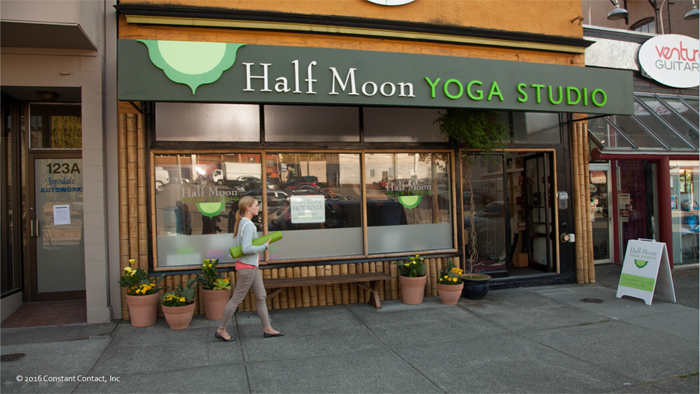
Half moon yoga is a small studio in MA who’s biggest goal was to generate revenue. For them, that means butts in seats (or on yoga mats).
When I consulted with them, they were putting effort into sending lengthy monthly emails, posting to every social media site they could think of, and hosting open house events. They were spread so thin, and they weren’t getting in front of the right people.
When we really sat down to think about their goal, I encouraged them to send short bi-weekly blasts about their class schedule, and to focus their social strategy primarily to Facebook, where we decided most of their clients are. Within months, they had doubled class attendance.
By helping Half Moon Yoga define what they were truly after, I was able to help them focus their budget and their time in the places that would yield the biggest bang for their buck.
The moral of the story is that you have endless options about how to market your business, but you don’t have endless resources. By learning to define your goals, we can narrow down which methods will be most effective to help you achieve success.
Setting Your Goals!
Every business or organization has 1 or 2 major objectives they’re trying to achieve. With so many options in the online marketing world, it’s easy to lose sight of what you’re ultimately striving for, which means losing time and money without seeing huge benefits. It’s important to be very clear about your specific objectives in order to determine your marketing strategy.
At the highest level, what is your organization hoping to achieve?
Many of us have similar goals. You might want to:
- Increase sales
- Drive referrals, and repeat business
- Engage volunteers, members, advocates
- Reach new customers or donors
- Nurture leads and relationships
Are you thinking “I want to do all of those things”? At different times during the year or during the life cycle of your business, these goals may change. This is when you need to be careful about spreading yourself too thin.
Trying to achieve too much all at once may take you away from your ultimate goal. If you had to prioritize, how would you rank them based on importance to your organization right now?
Download the free worksheets below.
[purchase_link id=”1712″ style=”button” color=”blue” text=”Purchase”]
“If you noticed the workbook that follows today’s session, on page 1 you’ll see a list of common goals for small businesses and non-profits. I’m going to challenge you to spend maybe 30 seconds ranking which of those match your current objective. Go with your first gut instinct.
Once you’ve determined your overall objectives, you can narrow down and write your own marketing goals.
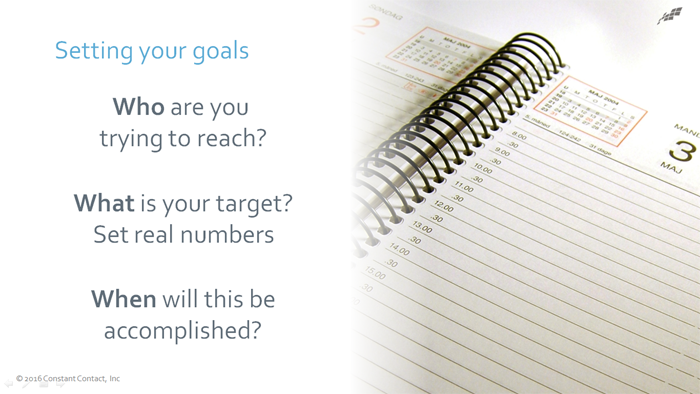
When writing your goals, it’s important to understand who you’re target audience truly is, in order to choose the right method of communication. Write down real numbers that are challenging, yet achievable and don’t forget to put a time frame on it. That way you’ll be able to push yourself to reach your goal within the specific time frame.
Online marketing services like Constant Contact have contact management tools that will help you to identify your target audience and tracking features that are going to play a role in determining success towards your goal.
Now you’re ready to write your own goals. Keep in mind, it probably works best to think short term, monthly or quarterly in this quick exercise. You can go big when you have more time and can take a step back and really look at this.
Choosing the Right Message – Pick your platform.
We’ve decided what we’re truly after, and we’ve made a tangible goal to measure our success. Now you’re ready to start designing the message that gets you there.
Start by focusing on the audience you’re trying to reach. Figure out where they are spending their time. For most people, that includes the inbox which is why email is such a compelling channel for small businesses.
But the same will also be true on social media where you need to figure out where you need to be to reach your target audience.
Remember back to the beginning of today’s session when we talked about all the ways your audience engages with you online through email and social media.
How are you supposed to decipher which platform is right for your goal when there are so many to choose from? Let me help you weigh the pros and cons.
What do you think is the percentage of email that gets delivered to the inbox? The answer is 90%!
How about social media…what is the largest social media site to-date? Facebook.
What do you think is the percentage of Facebook fans that see you in their news feed? This might surprise you, but only about 2% of your Facebook fans see your posts in their News Feed.
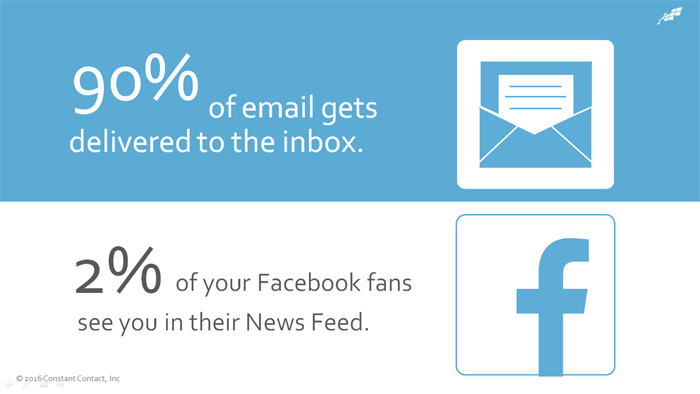
This stat is surely not to downplay the use of social media, as it plays a big role in online marketing strategies. Where email lacks, social media makes up for. And where social media lacks, email makes up for.
That’s exactly why we don’t recommend one or the other, we actually recommend BOTH. [SOURCE: https://blogs.forrester.com/nate_elliott/14-11-17-facebook_has_finally_killed_organic_reach_what_should_marketers_do_next]
We really need to leverage both platforms to get the maximum exposure we are seeking. Combining email and social media is great for gathering followers and building a reputation online. In fact, small businesses who combine email and social tend to see about:
- 73% more customer engagement
- 57% more new customers
- and 39% more business referrals
[Source: https://blogs.constantcontact.com/small-business-marketing-secrets/]
What benefits can you see to sharing an email on social media?
- Increase visibility
- By sharing your email on social media, you are able to get in front of more people rather than if you just sent it to your list.
- Grow your list
- Anyone who sees your email on social media who isn’t already on your list, they can opt to subscribe so they’ll receive messages straight to their inbox in the future.
- Save time
How much time do you spend trying to think of content for all of your different social media channels and your email?
You don’t have to create unique content for each of the different channels. Now all you have to do is to create your email and then posting to social media is just a click away.
One of the ways that Constant Contact helps you combine email and social is by allowing you to easily share your well-crafted email to your social media networks, making your marketing even faster and more effective.
Not only can you combine forces outside of your message, Constant Contact has tools to promote social media INSIDE your message.
When you place clickable links to your social media pages inside your emails, you’ll not only drive traffic to your pages, you’ll also get valuable tracking data that will tell you which social sites your subscribers are using most.
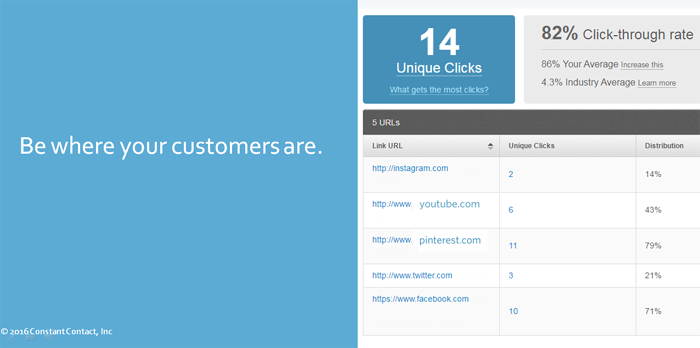
By comparing the amount of traffic you get to each of your social pages, you’ll be able to determine where to efficiently spend your time on social media.
Whichever platform is the most popular to your audience is clearly where you should be sending most of your time. You don’t have to be on every social media site to be successful. Constant Contact provides you with the tools to help you use your time more wisely.
When to send is another very common question. Both for how often to send and also when in terms of the time of day and the day of the week.
For social media, we recommend a baseline frequency of at least 3-5 times a weekly. It’s what they used to tell us for exercise. haha
There are tools and guidelines for what times have the highest traffic and most response but it
really depends on your industry, your audience and what you are trying to get them to do.
For email marketing frequency, monthly is the most common but it’s also a good idea to add unexpected messages every once in a while.
Once you’ve chosen your platforms, your ready to start thinking about and writing your messages. But I’ll warn you, you will not see the greatest success by simply picking your platform and blasting your goal(s).
In this new digital marketing arena, audience’s respond to brands they recognize and trust. How do you do that? Let me tell you.
In order to reach your goal in the long term, it’s not enough to choose the platform and immediately start promoting your agenda. People do not enjoy being sold to.
What they do enjoy is receiving content that not only speaks to their interests, but enables them to overcome a challenge, achieve a goal, or learn something they may not have already known. 61% of consumers are more likely to buy from companies that offer valuable custom content.
Clearly there is an impactful connection between offering something your audience cares about, and their likelihood to buy from you. Your job is to find the right balance of offering enough valuable content and also promoting your end goal. [Source: https://www.brafton.com/business-model/content-marketing/]
Most small businesses do not realize the importance of content in today’s marketing world. This is a striking concept. The fact is true that trust and value can directly impact purchases.
We typically encourage marketers to follow the 80/20 rule. This is a suggestive guideline about how to balance the amount of relevant content you share compared to the amount of promotion you offer.
In order to encourage your audience to engage with your goals, you must first prove your trustworthiness, credibility, and value. 80% of your message(s) should be valuable content, whereas 20% is reserved for your true promotion (directly tied to your goal).
For example, I work with a small accounting firm and of course they’re always looking to get more clients during tax season. Ultimately, their promotion is “let us do your taxes!” (with the ultimate goal of getting more clients and increasing revenue).
However, they can position themselves as experts and unveil some of their audience’s pain points by sharing content like the “most common mistakes on your tax returns” where they reveal some of the nitty gritty aspects of taxes.
How likely do you think the audience will be to make an appointment once they’ve shared this valuable content versus going straight to the promotion? Source: https://blogs.constantcontact.com/content-marketing-help/
[On page 1 of the workbook, there is a “Fill in the Blank” section. I’m about to give you the answers to the ‘fill in the blank’ right now”.]
Let me give you an example of how this guideline impacts your long-term goals. I recently worked with a real estate agent who couldn’t figure out how to maintain relationships with recent home buyers. After the close date, he obviously didn’t work as closely with those clients, but he knew they would be essential for word of mouth for new clients.
Think about it from his clients’ perspective. They’ve just bought the home of their dreams and a month later, they receive a newsletter about the newest homes on the market that doesn’t make the client feel very valued, right? So clearly he needed to maintain the relationship in a different way.
He kept a list of his recent home buyers and began sending them a variety of emails about “how to maintain your gutters”, “ideas for home décor”, “the best plumber in the area”, etc. And his call to action was always “share my message with your friends and family”. Because he balanced his content, he was able to reach his goal more effectively.
One effective way to do this is by turning your interactions with your customers, clients, members, supporters and volunteers into content for your email.
- Think for a second about the last interaction you had with someone at your organization. What questions did a customer or client have? What information are people requesting about your nonprofit? Can you turn an answer to their questions into an email? Here are some great examples.
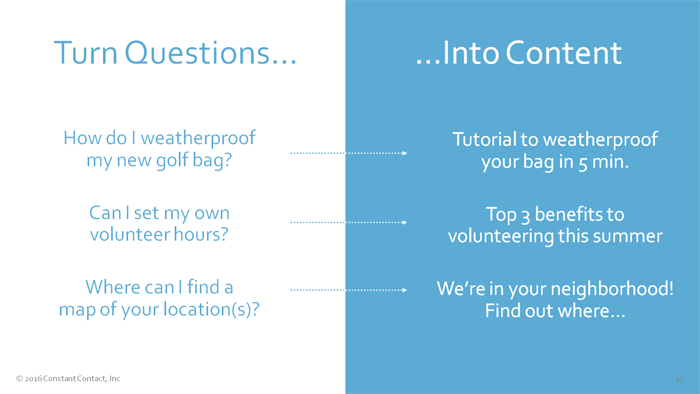
One easy way to practice this in real life is to create two columns – in a spreadsheet or document, or just on a piece of paper, with the questions you regularly get on the left.
In the right column, write down a way you can turn the answers to those questions into an email full of fresh, relevant content.
Guess what? These questions that you write on your paper can turn into your subject lines and headlines for social media. It’s that simple!
Subject lines are the first thing your audience sees before deciding whether to open your email. You only have a couple seconds to capture their attention and prove why your content is worth reading. There are really a lot of tips you can use to write a subject line, and here are a few:
- Keep it short and sweet (about 5-8 words) to entice them to open the message. This is especially important for the majority of your audience trying to read through their inbox on a mobile device.
- You could also include numbers in your subject line as it makes what you’re saying quantifiable and lets readers know exactly what they can expect. One example is “Top 3 benefits to volunteer this summer.”
- Encourage action, by including a call-to-action to get them to open the message immediately. One example for this is “Schedule your consultation today!” You can even include a deadline to create a sense of urgency. One example using this is “Summer sale ends Friday!”
Once you’ve written your subject line, this will double up as the headline when your email posts to social media. The great thing is that Constant Contact recognizes your subject line and automatically makes it your social media posts’ headline.
[This slide corresponds with the “Write your subject line” activity on page 2 of the workbook. “Now you’re going to write your own subject line based on your goals and your message.”]
Remember, you don’t have to stick to your own content. One of the biggest misconceptions about creating content for an email campaign is that you’re responsible for writing every single post or email. There are many resources you can use to find content that your audience will find valuable. For example, you can use:
- Interviews or testimonials (like from a staff member or satisfied customer)
- Social Media
- Google alerts
- YouTube
- Industry News
- Annual reports
- Competitor news
- Press releases
- Blogs (your own or someone else’s. Just remember to give credit!)
- Special guests
- Experts in the community
- Sponsors/donors/volunteers
- Partners who compliment your products/services
- Survey results
[Think about the type of content you can used to reach your marketing objective.
“You’ll find space on page 1 in the section titled “Choose your message” of your handout. Circle any message ideas that you think will help you to meet your goal.”
Think about the message you’ll send.”] Source: https://blogs.constantcontact.com/20-places-to-find-email-content
Whatever content you share, wherever you decide to share it, brand recognition is always important. It’s a great way to reinforce and build relationships with new or potential customers to increase your chances of achieving your long-term goals.
- Be consistent
- Take the “vibe” of your other marketing materials like your website and apply it to your email and social media marketing so it resonates with your audience
- People need to see your brand/promotion up to 20 times before they will engage with your organization/purchase
- Source: https://www.linkedin.com/pulse/how-often-does-someone-need-see-message-before-buy-filhaber
- Match colors
- Color can increase brand recognition up to 80%
- Source: https://www.zionandzion.com/the-influence-of-color-in-branding/
- Make sure it’s exact! Use free tools like color cop or digital color meter
- Choose your tone
- “Speak” the same in your email as you would in person, in a radio/tv ad, or on social media. Use the same language and tone to address your audience. It does impact the picture of your brand.
Constant Contact makes it easy to choose and fully customize a template to fit your branding and styling needs.
Don’t forget to think about the visual aspects of your message.
- Spotlight your products, services, employees and customers
- Include 3 or fewer images to get the best click-throughs.
Forrester study: video content increases click-through rates by 300%
- product demos
- customer testimonials
- promotional
- user-generated
With Constant Contact, you have the ability to easily add your images and make them clickable. This is especially great for adding in links to your videos.
The pajama program was doing a end-of-year push for warm winter donations. They made a video to recap their mission.
Want people to watch your video? Promote it on all of your marketing channels. That’s exactly what Pajama program did. They got the word out by promoting it using many of their marketing channels – promoted it in their email newsletter – and on their Facebook page using the social share tool when scheduling their email.
Keep mobile in mind to make your message easy to read.
Tip #1: avoid using multiple columns
Prior to the rise of mobile and mobile communication, emails had started to take on an almost website-like feel – with multiple columns and navigation elements similar to what you find on websites.
But with mobile communications driving content to be more focused, and also just to fit a more physically condensed space, multiple columns cause problems. The great thing with Constant Contact is that their templates are all designed to be mobile friendly and easy to read, no matter where your audience reads your email.
Tip #2: avoid using tiny fonts
This one would seem to be pretty self-explanatory…but is no less important. While you might be able to fit more text with smaller font, like 9 and 12 point font, who can read it? People will need to pinch-to-zoom the text, and then have to scroll around.
They’re more likely to delete the message, as well as unsubscribe from future small-font emails. We recommend at least 11 points for body text and 22 points for headlines, and starts to bring greater contrast between the text and the background. But even that it still hard to read.
Tip #3: use images carefully
Images are a great way to convey a message, tell a story…create a connection. But if you don’t carefully consider how you’re going to use images, you may end up with some unintended consequences that lead, at best, to someone not reading your email. Here are some things to keep in mind:
- some mobile email clients may not display images by default…so be sure that you’re using what is called “Alt Text,” or text that appears if the image doesn’t, to at least let people know what’s there.
- Great images still shouldn’t push the call-to-action all the way to the bottom of the message, making it less likely that the reader will actually click through.
- The position and size of the images matter too – You may need to resize images as you build your email (a lot of email marketing tools have simple, built in image-editing capabilities).
Before you send any message out to your customers or supporters, TEST THE EMAIL BY SENDING IT TO YOURSELF also a really beneficial feature when you’re creating your email in Constant Contact!! Be sure to view it with your readers in mind…and make changes accordingly. A few extra minutes of testing can save a lot of headache later.
Write A Call To Action!
We’ve done much of the hard part, believe it or not. We know what we’re after, we know what we’re going to ask of our audience. Now it’s time to promote the message.
Now that we’ve primed our audience with valuable content, they’re going to be more open to responding to our promotion. The fact that we have 20% of our marketing to encourage our audience to take action, we need to make sure that it’s really impactful in terms of helping us reach our goals. So how do we do that?
Maybe your #1 objective is to drive more revenue or donations…how do we actually get from this pretty goal in our workbook to putting money in the bank?
- Calls-to-action are the link between asking for what you want, and getting it. They are the lifeline of success, especially in email marketing.
Has everyone ever heard the phrase “call-to action”? Does anyone know what that means?
A call-to-action is a specific action your customers or members will take to help you reach your goal. Many times you’re asking readers to click to visit an important page that relates to your goal.
Unfortunately, we can’t force anyone to take action. There are certain things we can do to make that action more likely. A company called CreateDebate was able to increase clicks in their email by making it look like a button, instead of standard text by 45%!
That’s exponential compared to the average click-through rate anywhere from 5-10%, depending on most industries.
When you choose a template, you’ll be able to add and move buttons to go exactly where you need them.[Sources: https://www.copyblogger.com/call-to-action-buttons/, https://support2.constantcontact.com/articles/SupportFAQ/2499?q=industry+averages&l=en_US&fs=Search&pnx=1]
Here’s one example of the major impact a button can have on your goal. Notice the difference between a regular email from your own Outlook, Gmail or Yahoo account (on the left, below), and one sent through an email service provider like Constant Contact (on the right, below).

What do you notice in the difference between these two emails above? The email on the right clearly looks more professional, which will ultimately get you closer to achieving and surpassing your goals. With regular email (left) you have:
- Limited # of emails sent at once
- No formatting control
- No cohesive branding
- No tracking and reporting of email results
By sending an email through Constant Contact (right), you’ll have:
- beautiful templates
- Customizable, mobile-responsive, easy-to-use
- brand identity/recognition
- Features built to match your logo and colors, plus integrate your social media profiles and drive website traffic
- Actionable features like clickable images
- Built in buttons
- Best of all….trackable results
There are even more best practices you might not know about when designing an awesome call-to-action.
For example:
- Narrow down 1-2 per email
- One study showed that emails with a SINGLE call-to-action increased clicks by 371%? That’s a major difference.
- Use actionable language (like visit our website, order online, register by April 1st, request a copy, or download our guide)
- Above the scroll
- If you’re asking readers to take action, you need to catch them while they’re still paying attention.
- Use buttons Source: https://www.wordstream.com/blog/ws/2015/06/10/digital-marketing-stats
It’s time to determine our actual call-to-action. If we remember the goal of Half Moon Yoga, they really wanted to increase attendance and promote their schedule. What kinds of calls-to-action would be relevant for them? [there is no right or wrong answer, as long as the call-to-action relates back to the original goal. See examples on page 2 of the workbook.]
Calls to action:
If you want to drive traffic, you might ask people to “visit your website”. If your looking to increase your sales/donations, or maybe even drive new or repeat business we’ll ask people to “purchase today”, “schedule an appointment”, or even “donate”.
Think back to the goal you just wrote and look at the examples on page 2 of the workbook. You’ll see some pre-written options and you can also write your own if you don’t find one that fits.
At different points in the life cycle of your business, your goals may change and some of these calls-to-action may be more relevant. Here’s where it’s very important to focus on the top objective you’ve chosen for your organization.
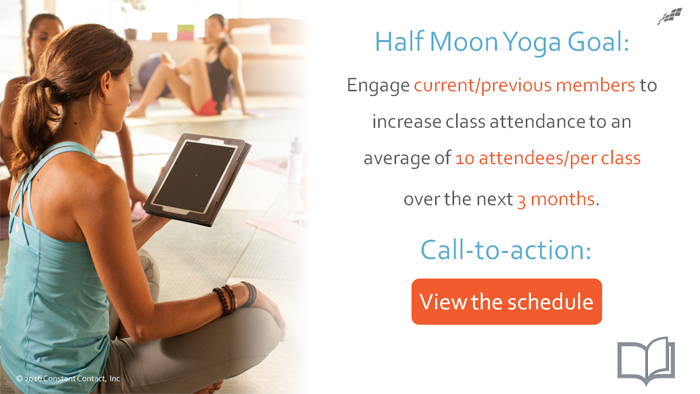
[ Utilize the examples on page 2 to come up with a call-to-action that will generate the best results based on the goal.]
Have you considered where your call-to-action would take your readers when they click?Where do you intend to drive your readers?
The more direct path you can provide to your readers, the more likely you are to accomplish your goal. So when you’re designing your call-to-action, how can you create a call-to-action that is direct as possible?
Well, Constant Contact has tools that allow you to drive your audience exactly where you need them to be. Let me share a couple examples…
For example, if someone says “I link everyone to my website”, ask them how direct their website is to their specific goal.
Do readers have to click more than 2 or 3 times to get to the end result? (ie, they want volunteers, but it takes readers to their info page where they have to download the application, print, fill out, and mail to the location. Is that the most direct route to getting more volunteers? Probably not.)
Have you considered other options besides your website Not everything has to be hosted there, especially if they don’t have the resources to make it happen.
We’ve proven earlier in the session that email + social is the best way to promote a message, so email will be the common denominator in this conversation.
But I want to help you realize that there are tools at your disposal to drive readers to a more direct page to accomplish your goals, which leads us to Constant Contact Plus campaigns.]
Last year, I met Hearts & Tails Animal Rescue who desperately needed volunteers. They had been sending emails to their subscribers where people would click on the call-to-action and be taken to their website where they had find the link to download the pdf form.
The volunteers then filled it out and mailed it or emailed it back as an attachment. Hearts & Tails then needed to manually input all of the volunteer information into their database, which took up a huge amount of man power.
Plus, they had no idea how many volunteers they were missing out on because they started the process and never finished.
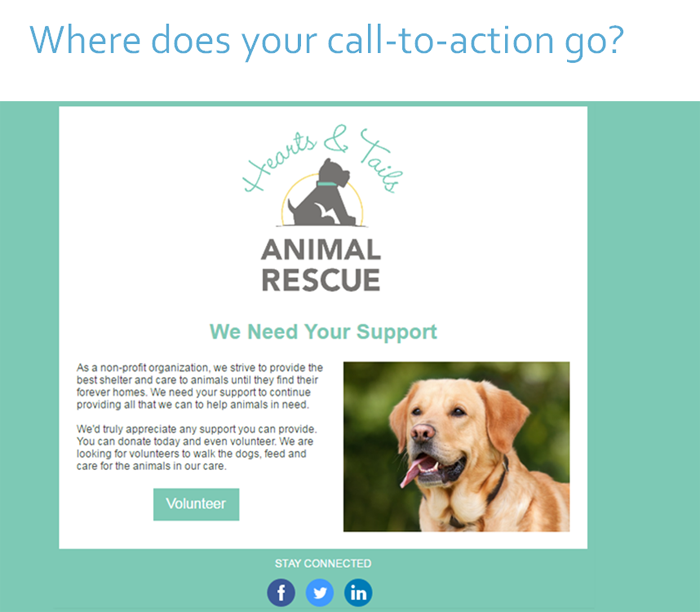
When I finally met them, a couple things were very clear: they had a good foundation for their message and an excellent call-to-action, but they hadn’t considered all their options in executing their goal.
By the end of our consultation, I set them up with an online form that would allow readers to click to “volunteer” and immediately enter their contact details and volunteer preferences.
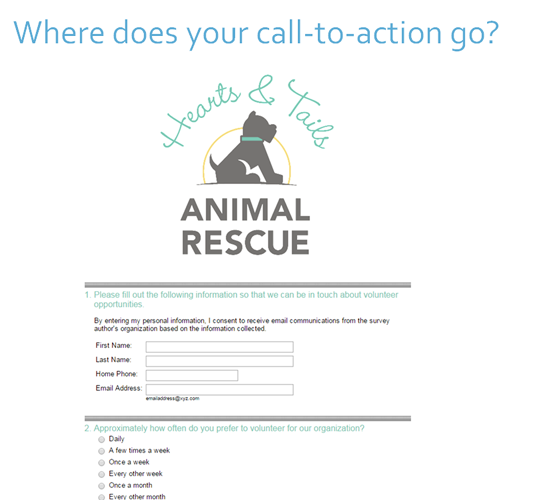
This simple change allowed Hearts & Tails to retain more volunteers by simplifying the application process, not to mention the time they saved by not having to manually enter the volunteer data. They gained 11 new volunteers last year, which was 1 more than their goal!
I’ve also spent some time working with Westin Downtown who runs an annual gala event. They were sending email invitations instructing people to RSVP via email.
Their registration limit was 500 people, so as you might imagine, they couldn’t keep up and things got messy. Registrants didn’t quite know what information to reply with and how to pay for the event.
Employees spent hours and hours speaking with customers, reading reply emails to register, tracking all of the registrations in their excel spreadsheet and then tracking and completing payments using a separate processing tool.
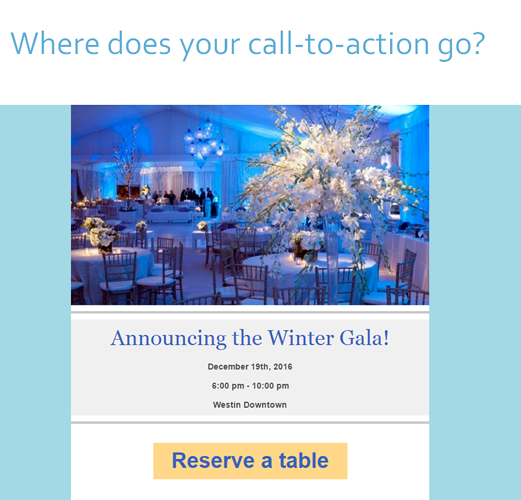
For those of you who run events, which of these challenges can you relate to?
Ultimately, they needed a tool that would automate their event management and provide their attendees with an easy way to register and pay. Instead of driving their call-to-action to an email inbox, attendees went straight to a short form to provide their information, and complete the payment right then and there.
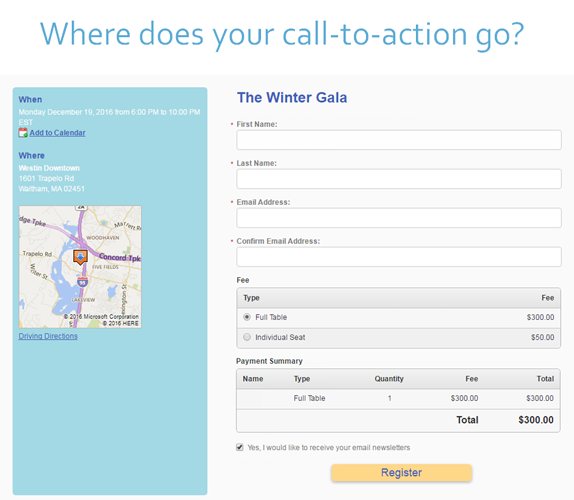
Last year, they sold out all of the tables, 2 weeks before the event.
Offer Coupons!
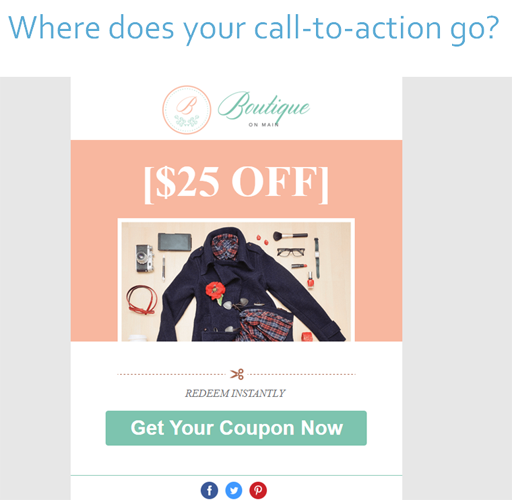
Here’s another business that I met a few years ago, Boutique on Main. For years, they had been offering coupons in magazines and newspapers in order to drive more sales.
The usage was low, they were targeting thousands of people in their local area, and couldn’t keep track of how many coupons were still floating around.
Part of specifying their goal was really about WHO they were offering their coupon to. By offering it to everyone all the time, they were cheapening their promotion.
A better strategy was to utilize their existing email subscribers who had recently engaged with their messages. I suggested an online coupon to reward regular customers and incentivize them to promote the coupon using social media, which increased their reach to qualified new customers.
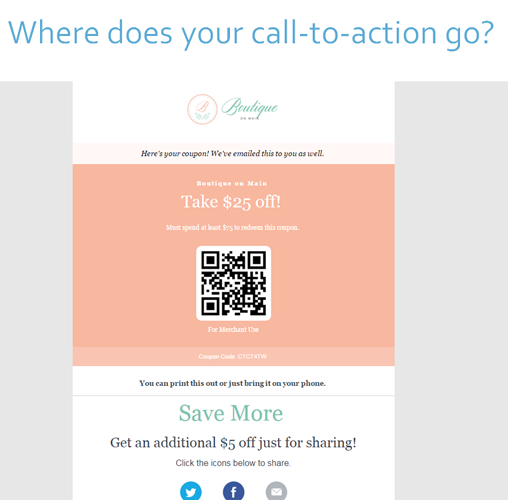
[Please complete the “Where does your call-to-action go?” activity on page 2. “On page 2 in your workbook, take a couple minutes to consider the most direct call-to-action based on your goal.” “Are there any examples here that you had never thought of before?”, “Are there any options that you plan to use that aren’t on the workbook?”]
Measuring Success!
At this point, we’ve executed our message. But what good does it do if we don’t follow up to see if we achieved our original goal?
[Are you closing the loop on your marketing goals and strategy. It’s not enough to set a goal, execute, and forget about it. It’s important to measure the results of one goal before moving forward with the next one.]
Have heard the phrase, “If you’re not measuring, you are not marketing”? It couldn’t be truer. Reports are going to help you to determine if you met your goal that we talked about at the beginning of this session.
Depending on your goal, you might use reports like: who is opening your emails, if they’re clicking on your call-to-action, how many people respond to your form or survey questions, how many sign up for your events, pay for your events or even claim or share a coupon.
Using an online marketing service like Constant Contact is going to help you save time and money because we track the actions that your subscribers take.
Let’s take a look at some of the results that our businesses used to measure their success.
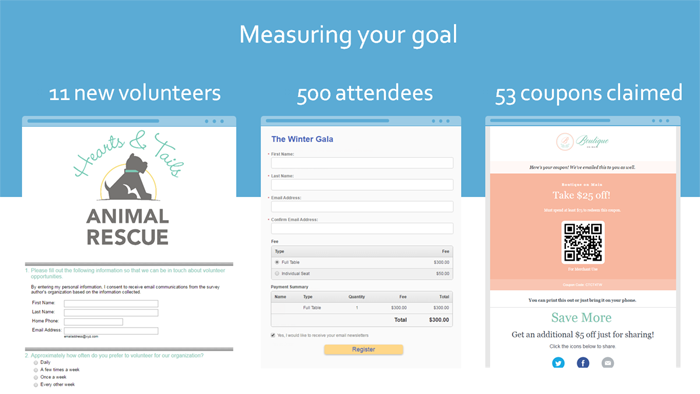
- Hearts and tails used a form to increase their number of volunteers. By driving readers directly to the online form, Constant Contact automatically recorded all submissions and all the details for interested volunteers. They could compare that end result directly to their goal to determine whether or not they were successful.
- The Westin Downtown automated their event RSVP process in an effort to save time and increase event registrants. Constant Contact’s tool allowed them to manage RSVPs, collect event payments, keep track of cancellations, and more.
- The Boutique on Main hoped to increase sales by offering a trackable coupon, which allowed them to measure how many coupons were redeemed and shared, without having to manually keep track.
No matter what your organization is trying to achieve at any given time, Constant Contact has the metrics to help you gauge whether or not you achieved your initial goal.
If you didn’t get to where you wanted to be, Constant Contact goes even further to provide you with metrics you need to make better/different marketing decisions for your next message.
Regardless of your end goal, we’ve established email is one of the most effective ways to promote your call-to-action. Not only because of the 90% of people you can reach in the inbox, but also because of the feedback you’ll receive as a sender. By using email, you’ll be able to measure how many people are viewing your message, and how many people are engaging with your call-to-action.
Here you’ll see a variety of metrics you’ll receive, but let’s talk about some of the most important metrics toward reaching your goal and how they can impact your future email marketing decisions.
- Opens – this metric is invaluable in helping you achieve your goals because if you’re not getting your audience to open your message, they’ll never have a chance to reach your call-to-action.
- First, you’ll want to take a look at the list of people who opened your email, you’ll see the day and time that they opened your email. This is where you’ll look for trends in the day of the week and time of day. This will help you to choose a better time when more contacts are more likely to open your email.
- Your subject line is one of the most important factors that affects your open rate, so make it attention grabbing using 5-8 words.
- Make sure your subject line is easily recognizable. Your audience should know who the email is coming from. In most cases, this will be your company name.
The industry average for this metric can range anywhere from 8% all the way to 28%. Remember, these are only averages, and they are different for every industry. If your metrics are within this range, you’re on track. But there’s also a great likelihood that your metrics will be higher if you follow the practices we’ve talked about. source: https://support2.constantcontact.com/articles/SupportFAQ/2499?q=industry+averages&l=en_US&fs=Search&pnx=1
- Click-throughs – You’ll also know whether your email was engaging and if they find value in the information you are sending. You’ll know who clicked on your link and took the action you requested. To improve your click rate, you want to:
- Be sure that your call-to-action is simple, descriptive, and easy for your contacts to understand what you’d like them to do.
- Make sure your link really stands out. Ideally, we suggest using a button with a contrasting color to really make it pop.
You may have received a few emails that you didn’t feel like they applied to you, so what did you do with those emails?
- You’ll be able to build better relationships and improve results with your customers or members by personalizing content and segmenting your contact list. While you can segment your list based on just about anything you know about the members of your audience, your reports will provide plenty of data to begin segmenting contacts. When you know that a group of your contact list opened your email or even clicked on a specific link in your email, you know that they are interested in that topic, so you’ll be able to save those contacts to their own list and send specific information in the future.
The industry average for this metric can range anywhere from 5% all the way to 18%. Remember, these are only averages, and they are different for every industry. If your metrics are within this range, you’re on track. But there’s also a great likelihood that your metrics will be higher if you follow the practices we’ve talked about. source: https://support2.constantcontact.com/articles/SupportFAQ/2499?q=industry+averages&l=en_US&fs=Search&pnx=1
How To Get Started.
Everything we talked about in today’s session is intended to help you grow your business. Strategies, tips and ideas that you can leave here and try. The good news is, success is well within your reach.
For those of you just getting started, here are your first steps.
- Start by writing out the specific goals you want to reach, then you’ll design your call to action and send the message to your target audience to get them to take action. Last, but not least, measure your results so you can keep sending, learning, and making the necessary adjustments with each email.
- Depending on your goal, remember to consider a direct route to your call-to-action. It may be your website, but it could also be an interactive page like an online form, or registration page
If you can benefit from a more direct call-to-action and an easier way to manage your marketing, it’s time to consider Constant Contact for more than just email. Constant Contact is committed to helping small businesses and nonprofits succeed in growing businesses. The tools are designed to help you get real results, just like you’ve seen in the examples today.
You might be sending email updates, running your own special offers or deals, or getting online feedback or run an online survey. No matter what you’re trying to achieve, Constant Contact has the tools, knowledge, and experts to help you get there.
I’d love to work with you! You can schedule a free phone call to talk about your goals and I’ll do my best to help get your plan set in motion. I even offer my services to assist and manage your constant contact campaigns. Either way, feel free to contact me anytime via my contact page.
Again, I’m Danna Crawford,
Thanks for joining me and I wish you only the best with your marketing success!

